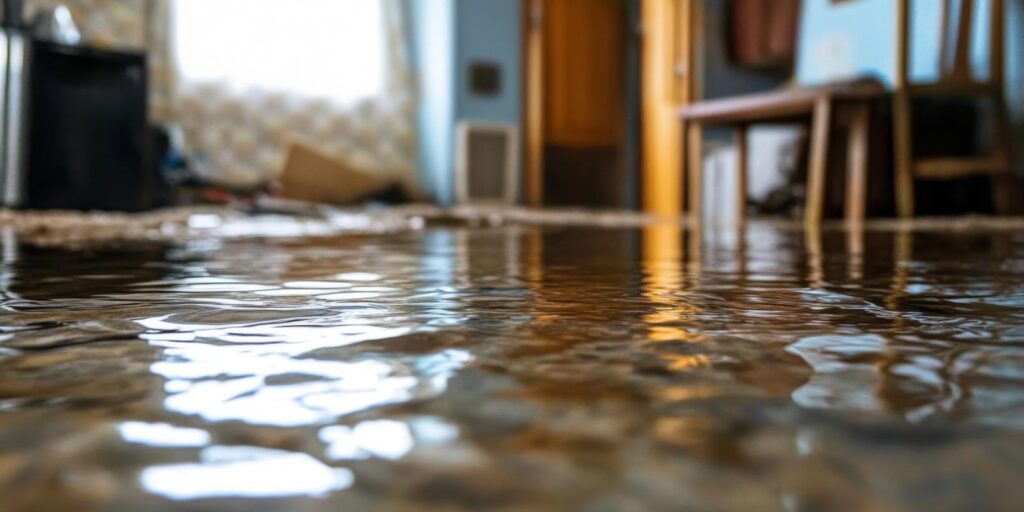
Contents
When faced with flood damage, your first step is to assess the situation carefully. You need to prioritize safety by shutting off utilities and evaluating the extent of the damage. From there, effective water extraction methods become vital, as the right equipment can greatly speed up the cleanup process. But what specific techniques and tools should you employ to guarantee thorough restoration? Understanding these details is fundamental for a successful recovery.
Key Takeaways
- Conduct a thorough damage evaluation and document affected areas to prioritize cleanup efforts effectively.
- Utilize submersible and utility pumps for efficient water extraction, along with wet vacuums for smaller spaces.
- Set up fans and dehumidifiers to promote drying and prevent mold growth in the affected areas.
- Wear protective gear during cleanup and remove contaminated materials safely to reduce health risks.
- Regularly inspect for moisture signs after cleanup and implement prevention measures to avoid future flooding issues.
Understanding the Scope of Flood Damage
When you face the aftermath of a flood, understanding the scope of the damage is essential for effective cleanup and recovery. Start by conducting a thorough damage evaluation, which involves documenting all affected areas and items.
Identify the flood impact on your property, including structural damage, mold growth, and damaged belongings. This careful appraisal helps prioritize your next steps and guarantees no critical issues are overlooked.
Make certain to take photographs and note any hazardous conditions, as this documentation can support insurance claims or local assistance programs.
Pay attention to both visible and hidden damages—water can seep into walls, floors, and electrical systems, leading to long-term problems if not addressed promptly.
Immediate Steps for Flood Cleanup
After evaluating the flood damage, it’s time to take immediate action to mitigate further issues. Start by prioritizing your safety and implementing emergency response procedures.
Make sure you’ve turned off the electricity and gas to prevent hazards.
Here are some essential steps to take into account:
Wear protective gear: Use gloves, boots, and masks to protect against contaminants.
Document the damage: Take photos for insurance purposes and create a detailed inventory of affected items.
Contact professionals: Reach out to water damage specialists for advice on next steps.
Water Extraction Techniques and Equipment
Effective water extraction techniques and equipment are essential for minimizing damage during flood cleanup. To tackle standing water efficiently, you’ll want to employ various pumping methods. Submersible pumps are particularly effective for deeper water, while utility pumps can handle smaller volumes and are easier to transport.
As you assess your situation, consider using extraction equipment like wet vacuums. These are invaluable for getting water out of carpets, upholstery, and hard-to-reach areas, ensuring you reduce moisture levels promptly.
For larger spaces, truck-mounted extraction systems can provide high-capacity removal, saving you time and effort. Incorporating these solutions not only accelerates the cleanup process but also helps prevent mold growth and structural damage.
Ultimately, using the right combination of pumping methods and extraction equipment empowers you to reclaim your space effectively and fosters a sense of community resilience in the face of adversity.
Drying and Dehumidification Processes
Although you’ve successfully extracted standing water, the next vital step in flood cleanup is implementing effective drying and dehumidification processes. Achieving ideal air circulation and moisture control is critical in preventing further damage.
Start by setting up fans and dehumidifiers to create airflow, which aids in drying surfaces quickly.
- Make sure windows and doors are open to promote natural ventilation.
- Monitor humidity levels with hygrometers to maintain a balanced environment.
- Rotate fans periodically to cover all areas, especially hidden spots.
Mold Prevention and Remediation Strategies
As you move forward in the flood cleanup process, prioritizing mold prevention and remediation is essential to safeguard your health and property. Mold growth can begin within 24 to 48 hours after flooding, so acting quickly is vital.
Start by thoroughly drying all affected areas, using fans and dehumidifiers to reduce humidity. Implement prevention measures like sealing cracks and ensuring proper ventilation to deter future mold issues. Regularly inspect your property for signs of moisture and address them immediately.
If mold does appear, wear protective gear and remove contaminated materials, like drywall or carpeting, following local guidelines. Using a mixture of water and detergent can help clean non-porous surfaces, but for extensive infestations, consider hiring a professional mold remediation service.
Long-term Restoration and Repair Solutions
After addressing mold concerns, it’s time to focus on long-term restoration and repair solutions to guarantee your property returns to a safe and functional state.
Effective restoration planning is essential for ensuring the longevity of your repairs and preventing future issues. Here are three key considerations:
Choose high-quality repair materials that withstand moisture and resist mold growth.
Create a detailed timeline for restoration to keep the process organized and efficient.
Consult professionals for specialized tasks, ensuring that all repairs meet safety standards.
Final Thoughts
In summary, addressing flood damage efficiently is essential for safety and long-term recovery. Did you know that mold can grow within 24 to 48 hours after flooding? This statistic underscores the importance of swift action. By prioritizing water extraction, drying, and remediation, you can greatly reduce health risks and structural damage. Implementing these effective solutions not only restores your space but also safeguards your well-being, ensuring a safer environment for you and your loved ones.
Recent Posts
7 Best Flood Cleanup and Restoration Solutions
Imagine standing in a room where the walls glisten with water, remnants of a flood
Fast Water Damage Recovery: FAQs Answered
When you face water damage, knowing the right steps to take can make all the
Reliable Guide to Swift Water Damage Recovery
Did you know that nearly 14,000 people experience a water damage emergency every day in
